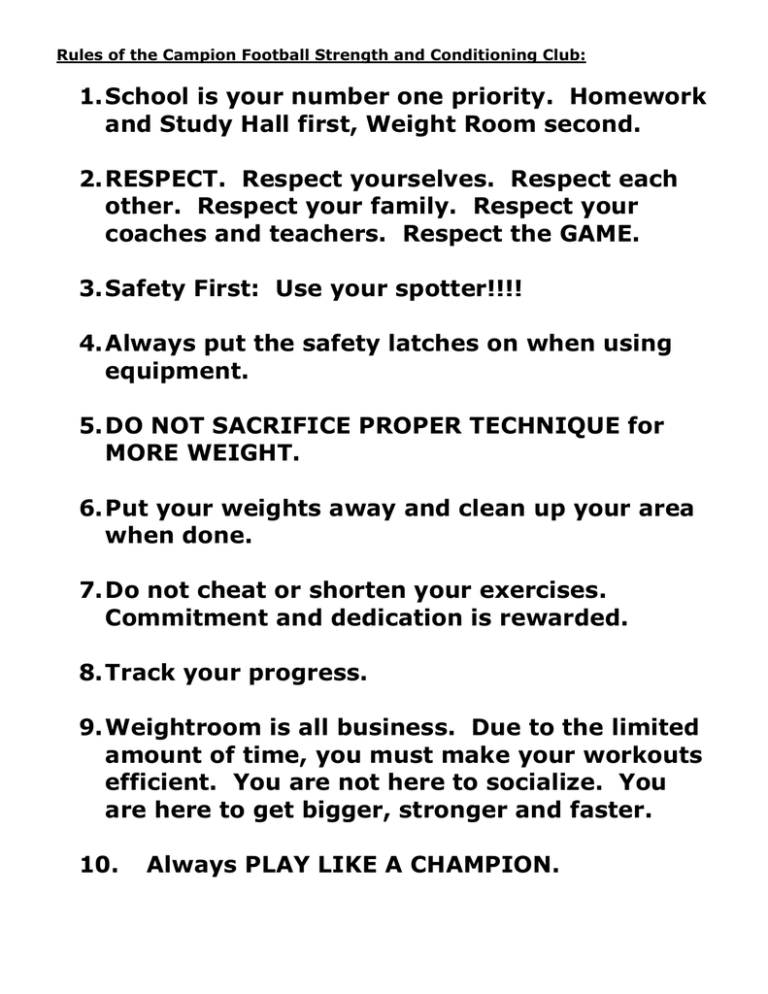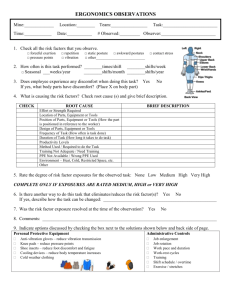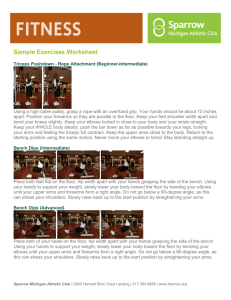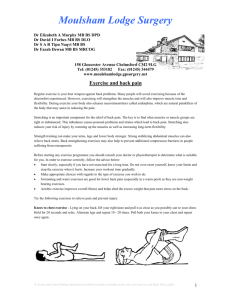1. School is your number one priority. Homework
advertisement

Rules of the Campion Football Strength and Conditioning Club: 1. School is your number one priority. Homework and Study Hall first, Weight Room second. 2. RESPECT. Respect yourselves. Respect each other. Respect your family. Respect your coaches and teachers. Respect the GAME. 3. Safety First: Use your spotter!!!! 4. Always put the safety latches on when using equipment. 5. DO NOT SACRIFICE PROPER TECHNIQUE for MORE WEIGHT. 6. Put your weights away and clean up your area when done. 7. Do not cheat or shorten your exercises. Commitment and dedication is rewarded. 8. Track your progress. 9. Weightroom is all business. Due to the limited amount of time, you must make your workouts efficient. You are not here to socialize. You are here to get bigger, stronger and faster. 10. Always PLAY LIKE A CHAMPION. Core Exercises and Auxiliary Exercises * Exercise are based on equipment availability in the CAMPION WEIGHTROOM. Core Exercises – Work many muscles simultaneously. Exercise Bench Press (Dumbell/Barbell) Muscles Worked Shoulders (Delts), Chest (Pecs), Triceps Incline Press (Dumbell/Barbell) Shoulders (Delts), Upper Chest (Pecs), Triceps, Upper Back Shoulders (Trapezius, Delts), Triceps, Upper Back Hips Flexors, Glutes, Hamstrings, Quadriceps, Groin, Lower Back (Erectors) Hip Flexors, Glutes, Hamstrings, Quadriceps, Groin Hip Flexors, Hamstrings, Glutes, Quadriceps, groin, Lower Back (Erectors) Groin, hip flexors, hamstrings, Quadriceps, Ankles Upper Back (Latisimus Dorsi, Rhomboids, Trapezius), Erectors, Biceps Shoulders (Trapezius), Erectors Shoulder Press (Dumbell/Barbell in front) Back Squat Leg Press Dead Lift Walking Lunge (Dumbell/Barbell) Lat Pulldowns Shrugs (Dumbell/Barbell) Auxiliary Exercises – Work one or a few muscles. Exercise Dumbell Flys/Pec Deck Bicep Curls (Standing/Seated) Tricep Extensions (Bar/Rope) Dips Wrist Curls Bent-Over Rows Seated Rows Leg Extensions Hamstring Curls Standing Heel Raises Front/Rear/Side Raises Upright Rows Chin Ups Assisted (Wide Grip) • Muscles Worked Chest (Pecs) Biceps Triceps Shoulders/Triceps/Chest (depending on movement) Wrists/Forearms Lats, Trapezius, rhomboids Lats, Trapezius, Rhomboids, Erectors Quadriceps Hamstrings Calves (Gastrocs, Soleus) Shoulders/Upper Arm (Deltoids) Shoulders/Upper Arm (Deltoids and Trapezius) Lats, Biceps Off Days – Abs/Stretching/Isometric and Isotonic exercises For workouts, combine 3 Core exercises and supplement with 2 Auxiliary. Each Core Exercise should have 4 Sets at 8-10 Reps each set. Each Auxiliary Exercise should have 4 Sets at 10-12 Reps each set. Working weight will be determined after determining your strength level. A sample plan might look like the following: Day 1 Bench Press or Incline Press Back Squat or Leg Press Shrugs Tricep Extensions or Dips or Wrist Curls or Dumbell Flys/Pec Deck Leg Extensions or Hamstring Curls or Standing Heel Raises Day 2 Shoulder Press Dead Lift or Walking Lunge Lat Pull Downs Bicep Curls or Bent Over Rows or Seated Rows or Chin Ups Assisted Front/Rear/Side Raises or Upright Rows DETERMINING YOUR STRENGTH LEVELS – Core Exercises To determine your strength level for a particular exercise, refer to the following steps. All players will be monitored at some point during their training to determine their proper strength level by a coach. Be sure to record your strength level for each exercise in the space provided along with the date. 1. Do 10 repetitions of the exercise with just the bar. Rest for 2 minutes. 2. Add 10 pounds on each side and do 10 more repetitions. Rest for 2 minutes. 3. Add another 10 pounds on each side and do 10 more repetitions. Rest for 2 minutes. 4. Continue this process until you cannot do 10 full repetitions using proper technique. 5. The last weight at which you can complete 10 repetitions becomes your strength level. Using this weight and the number of reps you completed, find your calculated single rep max using Appendix A. 6. Continue the same process for each core exercise. 7. Do not do more than three core exercises per day. If you need to find your strength level in six exercises, do three on one day, the other three on the next. Spread the exercises out to be sure you get enough rest. 8. The 45 lb. Olympic Bar may be too heavy for you. If it is, work with dumbbells until you are strong enough to use the proper bar. You may find that you already have some strength and the bar is too light for you. If this is the case, ask one of the coaches to help you determine your starting weight. 9. Once you have determined your strength level, over the course of your training you will change the number of reps and sets as well as your working weight as you progress. Appendix A: Personal Best Conversion Chart How to use the chart. - the far left column (10) represents your strength level (the amount of weight you can lift for 10 repetitions using proper technique). The far right column (1) shows what should be your single rep max (the maximum amount of weight you can lift for 1 repetition) depending on your strength level. In the initial building phase while you are all familiarizing your bodies with weight training, you will be working with between 8-10 repetitions. This will change over time as you become used to the weight and you get stronger and your technique improves. 10 9 8 115lbs 115 125 135 145 155 160 170 175 185 190 200 205 115 120 130 140 150 160 170 180 185 195 200 210 215 120 125 135 145 155 165 175 185 190 200 205 215 220 Number of Repetitions 7 6 5 4 120 130 140 150 160 170 180 190 195 205 210 220 225 125 135 145 155 165 175 185 195 200 210 215 225 230 130 140 150 160 170 180 190 200 205 215 220 230 235 135 145 155 165 175 185 195 205 210 220 230 240 245 3 2 1 140 150 160 170 180 190 200 210 215 225 235 245 250 145 155 165 175 185 195 205 215 220 230 240 250 260 150 160 170 180 190 200 210 220 230 240 250 260 270 Once you have determined your strength Level, record it here in your book for your first cycle. This will be used at the end of the cycle to track your improvement. Core Exercise Name Strength Level (amount of weight lifted for 10 repetitions using proper technique) * Auxiliary exercises weight will be determined by your comfort levels and ability to perform using proper technique. Exercise DATE: Core Exercise #1: ____ ____ ____ ____ Core Exercise #2: ____ ____ ____ ____ Core Exercise #3: ____ _______________ ____ ____ ____ Auxiliary Exercise ____ #1: ____ _______________ ____ x x x x x x x x x x x x x x x DATE: 10 8 8 8 10 8 8 8 10 8 8 8 10 10 10 ____ ____ ____ ____ ____ ____ ____ ____ ____ ____ ____ ____ ____ ____ ____ x x x x x x x x x x x x x x x DATE: 10 8 8 8 10 8 8 8 10 8 8 8 10 10 10 ____ ____ ____ ____ ____ ____ ____ ____ ____ ____ ____ ____ ____ ____ ____ x x x x x x x x x x x x x x x DATE: 10 8 8 8 10 8 8 8 10 8 8 8 10 10 10 ____ ____ ____ ____ ____ ____ ____ ____ ____ ____ ____ ____ ____ ____ ____ x x x x x x x x x x x x x x x DATE: 10 8 8 8 10 8 8 8 10 8 8 8 10 10 10 ____ ____ ____ ____ ____ ____ ____ ____ ____ ____ ____ ____ ____ ____ ____ x x x x x x x x x x x x x x x 10 8 8 8 10 8 8 8 10 8 8 8 10 10 10 Auxiliary Exercise ____ x 10 #2: ____ x 10 _______________ ____ x 10 ____ x 10 ____ x 10 ____ x 10 ____ x 10 ____ x 10 ____ x 10 ____ x 10 ____ x 10 ____ x 10 ____ x 10 ____ x 10 ____ x 10 Exercise DATE: DATE: DATE: DATE: Core Exercise #1: DATE: ____ ____ ____ ____ ____ Core Exercise #2: ____ ____ ____ Core Exercise #3: ____ _______________ ____ ____ ____ Auxiliary Exercise ____ ____ #1: _______________ ____ x x x x x x x x x x x x x x x 10 8 8 8 10 8 8 8 10 8 8 8 10 10 10 Auxiliary Exercise ____ x 10 #2: ____ x 10 _______________ ____ x 10 ____ ____ ____ ____ ____ ____ ____ ____ ____ ____ ____ ____ ____ ____ ____ x x x x x x x x x x x x x x x 10 8 8 8 10 8 8 8 10 8 8 8 10 10 10 ____ x 10 ____ x 10 ____ x 10 ____ ____ ____ ____ ____ ____ ____ ____ ____ ____ ____ ____ ____ ____ ____ x x x x x x x x x x x x x x x 10 8 8 8 10 8 8 8 10 8 8 8 10 10 10 ____ x 10 ____ x 10 ____ x 10 ____ ____ ____ ____ ____ ____ ____ ____ ____ ____ ____ ____ ____ ____ ____ x x x x x x x x x x x x x x x 10 8 8 8 10 8 8 8 10 8 8 8 10 10 10 ____ x 10 ____ x 10 ____ x 10 ____ ____ ____ ____ ____ ____ ____ ____ ____ ____ ____ ____ ____ ____ ____ x x x x x x x x x x x x x x x 10 8 8 8 10 8 8 8 10 8 8 8 10 10 10 ____ x 10 ____ x 10 ____ x 10 Bench Press/Incline Bench Press 1. Lie on a flat bench with eyes directly under the bar. 2. Keep feet flat on the floor with hands spaced evenly slightly wider than shoulder width. 3. Lift bar off the racks and slowly lower the bar to the highest point on chest. 4. Drive the bar upwards and back over the eyes to arms length while exhaling. Shoulder Press Overhead Dumbbell Press Strengthens the front of the shoulders (anterior deltoid) and the upper back (upper trapezius). There is also some benefit for the back of the upper arms (triceps). Exercise: 1. With a dumbbell in each hand, stand with shoulder-width apart. Keep the knees slightly bent. 2. Raise the dumbbells to the sides of your shoulders with the palms facing front. Your elbows should be close to the body, pointing down. The top of the dumbbells should be about level with the tops of your shoulders. 3. Take a breath, hold it and keep our abdominals tight then smoothly lift the dumbbells overhead till your arms are straight with the elbows just slightly bent. Exhale as soon as you pass the hardest part of the lift. (Holding your breath for just a split-second as you start the lift gives support to your spine). 4. Slowly lower the dumbbells to starting position. Performance tips: 1. Your arms are straight in the ending position but be sure that you are not locking your elbow joint. 2. Do not allow the dumbbells to drift forward or backward in the ending position. 3. In the uppermost position, your elbows should be next to your ears, not in front of them. 4. Keep your abdominals tight and do not allow your lower back to arch to lift the dumbbells up. 5. If you have ever had any kind of shoulder joint problem, avoid this exercise. Repetitions: To increase the size of the muscle, use a weight heavy enough to get you tired after only eight repetitions. Rest. Do one or two more sets. Squats 1. 2. 3. 4. If just beginning, work with a trainer to learn proper technique. Always have one or two competent spotters available. Position the squat rack so the bar sits about 3 inches lower than your shoulders. Position your hands evenly on the bar and and back up and under the bar so it rests comfortably on your shoulders. 5. Maintaining a wide stance place your feet squarely under the bar and lift it from the rack using the legs. 6. Keep the weight centered; do not lift from your heels or toes. 7. Slowly bend your knees while keeping your torso erect. 8. At the bottom of your movement the angles of your knee joint and hip joint are nearly equal. 9. Never relax or drop to the bottom position. Remain constant, slow, and controlled muscle tension. 10. Slowly return to starting postion while keeping your torso and back erect and hips under the bar. 11. At the end of the exercise have your spotters help to guide the bar back to the rack. Tips for Avoiding Injury The squat can cause a great deal of stress and strain on the knees even for those with no history of knee problems. By varying your foot placement you can change that stress. Using a wide stance decreases the stress on the posterior cruciate ligament (PCL). A narrow stance significantly increases stress. The angle of the foot (toes turned out or toes pointed straight ahead) however, does not affect the stress on the knees. There is no evidence that the squat exercise produces excessive force in the anterior cruciate ligament (ACL). Seventy-five percent of all squatting injuries occur before or after the actual lift; either moving into position or returning the weight to the rack. Make sure you have competent spotters at all times. Leg Press Instructions Preparation Sit on machine with back on padded support. Place feet on platform. Extend hips and knees. Release dock lever and grasp handles to sides. Execution Lower sled by flexing hips and knees until knees are just short of complete flexion. Return by extending knees and hips. Repeat. Comments Adjust safety brace and back support to accommodate near full range of motion without forcing hips to bend at waist. Keep knees pointed same directions as feet. Do not allow heels to raise off of platform, pushing with both heel and forefoot. Dead Lift position for the dead lift 1. Standing in front of a barbell with your feet under the bar, grasp the barbell in an alternate grip (one hand under grip, one hand over grip) with your hands roughly 2 feet apart. Bend over the bar keeping your back straight, knees slightly bent, head up and thrusting your butt out. execution of the dead lift 1. Without bending your arms, lift the weight from the floor until your body is completely upright. Lower the weight to the floor and repeat the movement. 2. Keep the movement fluent, slow, and controlled. Walking Lunge The Lunge is a simple but very effective exercise for the legs. It involves balance and coordination, which is very useful for sports as well as muscle development. The dumbell version of the Lunge is the easiest to start with though it can also be done with a barbell. How to do it: • • • • Hold two dumbells in your hands by your sides. Step forward with one leg and lower your upper body down, bending your leg (don't step out too far). You should have about two to two and a half feet between your feet. Do not allow your knee to go forward beyond your toes as you come down, keeping your front shin perpendicular to the ground. Push up and back and repeat with the other leg or do all the reps with one leg then switch. • • • • • The farther forward you step, the more the glutes and hamstrings you will use (closer works the quads more, just don't go too close). It is very important to keep your upper body vertical. Go down until your bottom knee almost touches the ground. Think about sitting back when doing these. This will prevent you from leaning too far forward. It is best to do this exercise all on one leg without standing up each time. Stepping forward can overstress your knee. Simply do all your reps on one leg then switch legs and do all your reps on the other leg. Lat Pulldowns Technique 1. Attach a long bar to the lat pulldown machine, and adjust the thigh pads so that when you are sitting your knees are at right angles and feet flat on the ground. 2. Grasp the bar using a wide grip and sit down maintaining the upper body in an upright position, slightly leaning back from the hips. 3. Pull the bar in front of your face to the top of your chest and pause. 4. Slowly release the bar back to the starting position by straightening your arms. Points to remember 1. avoid jerky movements 2. keep shoulders down to stabilize the scapula and isolate the lats. Alternatives 1. The grip can be either facing forward or facing back to you. Each grip will use the muscles differently. 2. Avoid the potentially dangerous behind the neck technique alternative. Shrugs (Dumbells/Straightbar) Instructions Preparation Stand holding dumbbells to sides. Execution Elevate shoulders as high as possible. Lower and repeat. Comments Since this movement becomes more difficult as full shoulder elevation is achieved, a height criteria for shoulder elevation may be needed. For example, raising the shoulders until the slope of the shoulders become horizontal may be considered adequate depending upon individual body structure. Dumbell Flys/Pec Deck FLYS Lie supine on a flat bench with two light dumbells at arms length above the shoulders with the palms of the hands facing each other. Keeping the arms as straight as possible, lower the dumbells out to each side of the chest in a semicircular motionuntill the weights are about even with the sides of your chestbut back slightly so they are nearly in line with your ears. From this position return the weights back above the chest using the same path you used originally. Exhale as you reach the top position. You must breathe heavilly, hold your chest high, keep your head on the bench and concentrate on the pectorals. PEC DECK Sit facing away from the machine, holding the handles or with your arms behind the pads. Your arms should be parallel with the floor and in line with your body. Bring your arms in front of you in an arc fashion until your hands meet in front of your chest. Reverse the movement on the way back. Spotter Information: A spotter can stand in front of the individual and spot at the elbows or wrists. Bicep Curls Barbell Curl Preparation Grasp bar with a shoulder width under hand grip. Execution With elbows to side, raise bar until forearms are vertical. Lower until arms are fully extended. Repeat. Comments When elbows are fully flexed, elbows should only travel forward slightly allowing forearms to be no more than vertical to allow for a relative release of tension in muscles between repetitions Tricep Extension This exercise is one of the most popular and effective exercises for building the tricep muscle. The Tricep Extension focuses on all areas of the tricep muscle. Do not lift so heavy that your elbows leave your sides during execution of this movement. This exercise can be used with a V-Bar, rope or a straight bar. Starting Position: Grasp a V-bar with a close grip. Palms should be facing down on this exercise. Your feet should be together and you should be leaning slightly forward with elbows at your side. • • • Start by pressing the bar all the way down towards the fronts of your thighs. Allow the weight to slowly lift back up using control until the forearms are perpendicular to the torso. Then press the bar back down towards the floor extending arms fully while feel a contraction in the triceps. Dips Extend yourself at arms length above the bars, then lower yourself slowly until ninety degrees then back to the top. The more forward you lean, the more chest muscles are activated. Spotting A spotter is optional and should stand behind the participant with hands on the trainers feet or tibia. Bench Dips Place two benches Parallel to each other. From standing in th middle of them, place your hands on the edge of the back bench and your feet on the front bench. By bending at the elbows, lower yourself as far as you can. To raise your body back up, extend your elbows until you arms are fully extended but your elbows are not locked. To make this exercise more difficult, place weighted plates across your thighs. Spotter Information: A spotter is not necessary. Wrist Curls (Reverse) Preparation Sit and grasp dumbbell with underhand grip. Rest forearm on thighs with wrist just beyond knee. Execution Allow the dumbbell to roll out of the palm down to the fingers. Grip dumbbell back up and flex wrist. Lower and repeat. Continue with opposite arm. Comments Keep elbows approximately wrist height to maintain resistance through the full range of motion. Bent Over Rows (Single Arm) Preparation Kneel over side of bench with arm and leg to side. Grasp dumbbell. Execution Pull dumbbell to side until upper arm is just beyond horizontal or height of back. Return until arm is extended and shoulder is stretched forward. Repeat. Continue with opposite arm. Comments Allow scapula to articulate but do not rotate torso in effort to throw weight up. Seated Row position for the cable row seated 1. Grasp the seated pulley handles with palms facing inward. 2. Slowly straighten your arms, sit down and secure your feet firmly on the feet apparatus. 3. Make sure your knees are slightly bent in the start position with your back straight. 4. Slightly lean forward. execution of the seated row cable 1. Pull the cable horizontally into your mid section while keeping your back straight. Keep your elbows close to your body and pull your arms back. Hold for a second and slowly allow your arms to straighten, slowly stretching your lats. Repeat the movement. 2. Keep the movement fluent, slow, and controlled. Leg Extensions Preparation Sit on apparatus with back against padded back support. Place front of lower leg under padded lever. Position knee articulation at same axis as lever fulcrum. Grasp handles to sides for support. Execution Move lever forward by extending knees until leg are straight. Return lever to original position by bending knees. Repeat. Comments Stabilizers are used during heavy resistances to prevent body rising off of seat. Hamstring Curls Preparation Facing bench, stand between bench and lever pads. Lie prone on bench with knees just beyond edge of bench and lower legs under lever pads. Grasp handles. Execution Raise lever pads to back of thighs by flexing knees. Lower lever pads until knees are straight. Repeat. Comments Keep torso on bench to reduce hyperextension of the lower back. Most machines are angled at the users hip to position the hamstring in a more favorable mechanical position. Heel Raise Starting Position: Start with feet shoulder-width apart, knees slightly bent, and engage the abdominals to help support the lower back. Action: Plantarflex up on the toes. Pause, then slowly lower to the starting position. Variation: One foot at a time, hanging hte heel of the working leg off the edge of a bench while the other leg maintains full contact with the bench. Equipment Variations: • • Dumbbells held at waist or shoulder level Weighted bar held on top of the shoulders Common Error: Error: Leaning forward with the trunk while lifting the heels Correction: Maintain a neutral spine by engaging the abdominals and stabilizing the spine, and not allowing the hips to move during the execution of the exercise. Front/Side(Lateral)/Rear Raises Instructions – Lateral (side) Raises Preparation Grasp dumbbells in front of thighs. Bend over at hips slightly with knees bent. Execution With elbows slightly bent, raise upper arms to sides until elbows are shoulder height. Maintain elbows' height above or equal to wrists. Lower and repeat. Front Raises 1. Stand upright with your feet shoulder width apart and your knees slightly bent. 2. Let your arms hang in front of your body with each hand holding a dumbbell, ends facing front to back. 3. Inhale and lift your arms out and away from your body, using your shoulders, until your hands are at shoulder height. 4. When you reach the top position the arms and body should resemble the letter "T". 5. Lower your arms, using the shoulders, back to the starting position. 6. For added variety, at the top of the movement turn the hand in a "tea pouring" motion. Rear Raises Using dumbbells, bend over at the waist with your feet shoulder width apart. Keep a slight bend in the knees to prevent stain on the lower back. Hold the dumbbells at arms length in front of you with the palms of your hands facing each other. Keep a slight bend in your elbows. Using your upper back strength, raise the dumbbells to the back and upwards in a semicircular arc as far as you can. Hold this position for a second to maximize the peak contraction in the rear deltoids. Lower the dumbbells back to the starting position. Repeat. Upright Row With an overhand grip, and hands comfortably apart, let the weight hang directly in front of you. Lift the bar straight up, keeping the bar close to your body. Lift until your elbows and forearms are level with the ground. Lower the weight slowly to the starting point. Note:This exercise is dangerous if it is done improperly. As well, discomfort may be felt in the wrists. (Discontinue with this exercise) Spotter Information: A spotter can be in front of the individual making sure that the individual completes the repetition. Chin Ups Reverse Grip Chin Muscles affected. Biceps and Brachialis (front of upper arm), Latissimus Dorsi (back), Trapezius (upper back), Teres major and minor (shoulder), Rhomboids (back), Deltoids (shoulder), Triceps (back of upper arm), forearm, Abdominals. Very difficult because of radial forearm muscles involved. Instructions: Reverse grip on handles, palms facing away from face. Hanging position, cross legs or bend knees if necessary. Action: Pull up, chin above level of handles. Control on way down. Regular Grip Chin Muscles affected: Same as above. Less difficult - has forearm power to pull in. Instructions: Palms facing chin - instructions same as above. Action: Same as above.do wn slowly arms are again. until your straight




